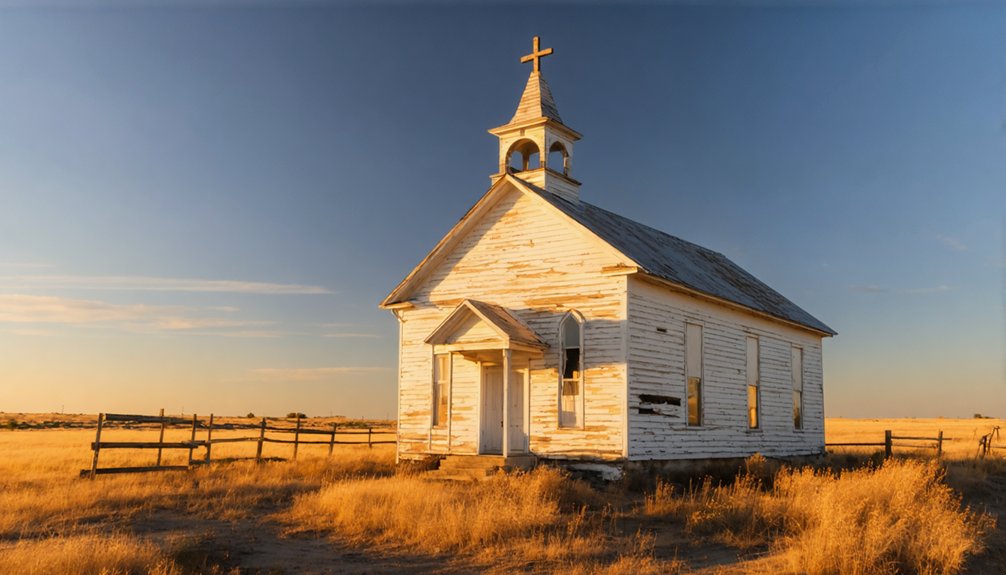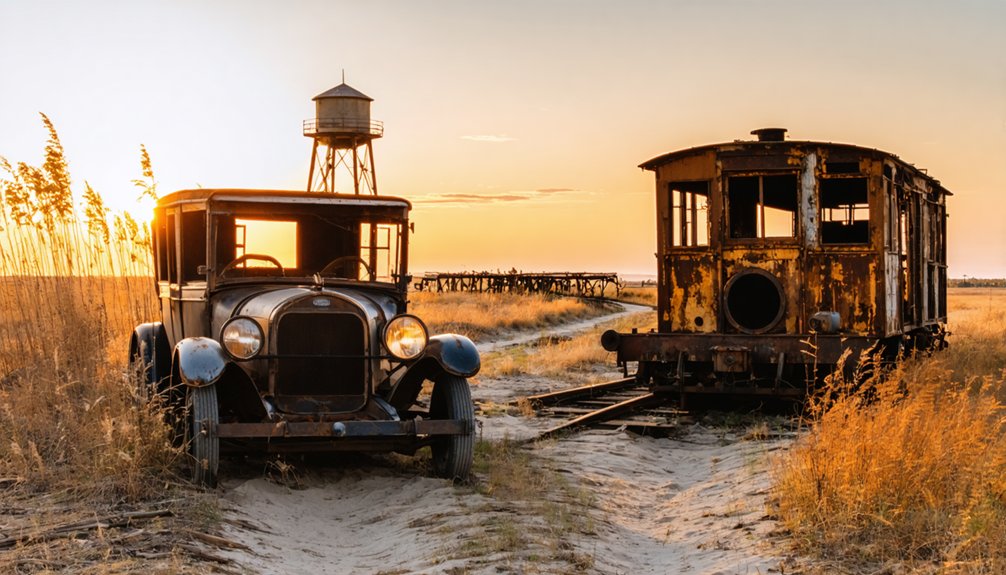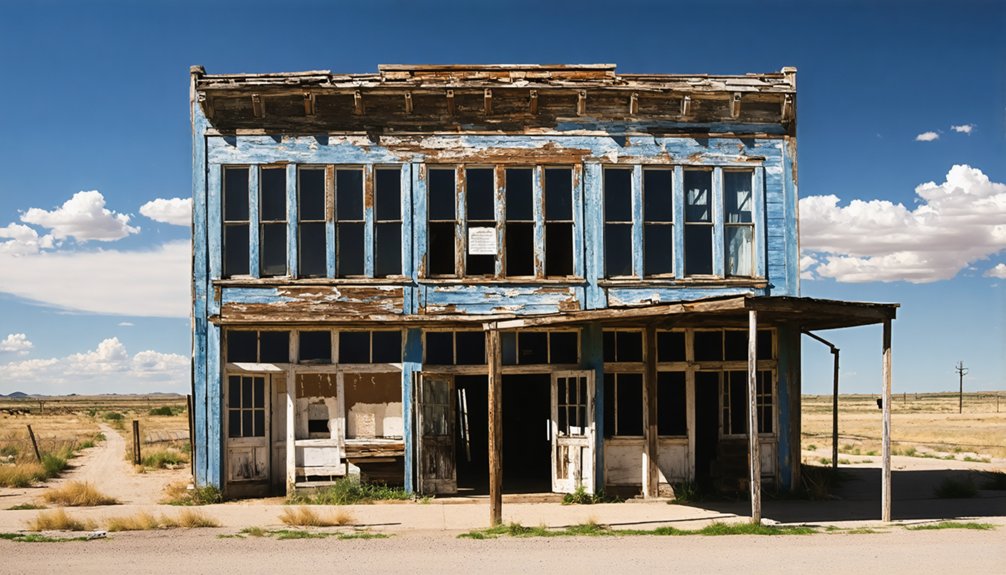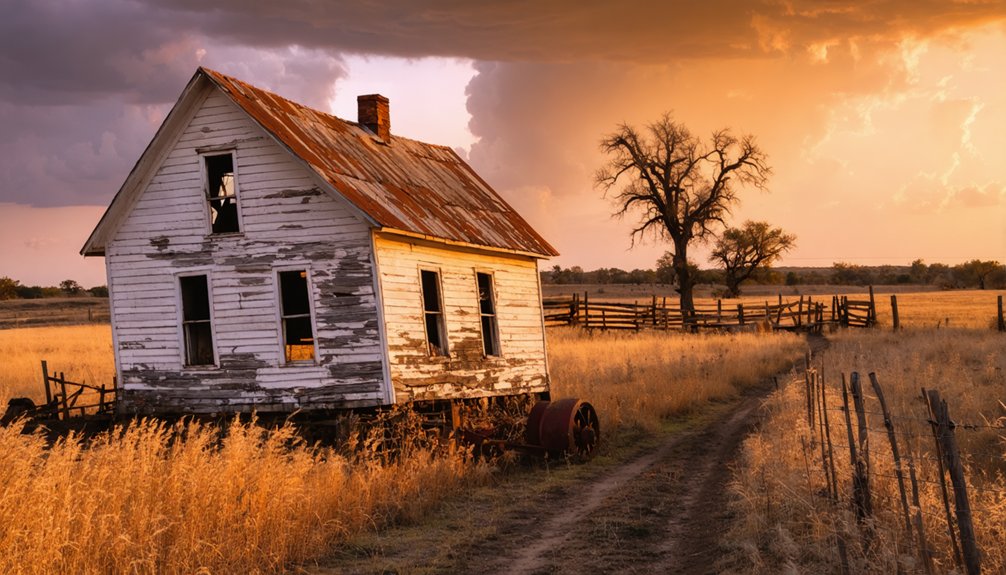You’ll find Pear Valley, Texas nestled between State Highways 83 and 283, accessible via Farm Road 504. Founded in 1908, this frontier settlement thrived on agriculture and local commerce before declining mid-20th century due to transportation bypasses and economic shifts. Today, its fieldstone church stands as the most prominent reminder of early settler life, while the surrounding area maintains a small but active population. The town’s preservation efforts and community spirit reveal a deeper story beneath its ghost town status.
Key Takeaways
- Pear Valley was founded in 1908 as a rural settlement in Texas, relying on subsistence farming and local businesses for survival.
- Population decline occurred in mid-20th century due to isolation from railroads and changing transportation patterns.
- The historic fieldstone church remains the most prominent surviving structure, though it no longer holds regular services.
- The town is accessible via Farm Road 504 between State Highways 83 and 283, suitable for standard vehicle access.
- Limited preservation efforts exist to protect remaining structures, with weather damage and maintenance threatening historic buildings.
The Origins of a Rural Texas Settlement
As westward expansion brought settlers to Texas in the late 19th century, Pear Valley emerged as a rural settlement built on agricultural promise.
You’ll find that settler experiences revolved around the practical needs of frontier life, with veterans and blacksmiths among the early pioneers who shaped the community’s foundation. Much like Henry Kimball, who was an ex-soldier and blacksmith, these skilled trades were vital to establishing new settlements.
The geographic significance of Pear Valley centered on its fertile lands and proximity to water sources, though exact details await further documentation. Much like the story of Barney Plemons using his horse’s ability to detect safe river crossings, finding reliable water access was crucial for early Texas settlements.
You won’t find fancy promotional naming here – the town’s name likely stemmed from local pear groves or flora that caught the settlers’ attention.
Like many frontier communities, Pear Valley’s location along travel routes played an essential role in its establishment, reflecting the strategic thinking of those early Texas settlers who sought both sustenance and connectivity.
From Saddle Creek to Present Day
While Saddle Creek initially served as a geographic anchor for early settlers, Pear Valley emerged as a distinct rural community shaped by the region’s shifting transportation patterns.
Much like early Spanish colonists who established El Camino Real to connect settlements, the development of roads was crucial to Pear Valley’s growth and eventual decline.
You’ll find its story mirrors many rural Texas settlements, where railroad bypasses and changing regional demographics led to gradual decline.
Like the decline seen in Thurber when oil-burning locomotives replaced coal power, shifts in transportation technology often spelled the end for small Texas communities.
Life in Modern Pear Valley
You’ll find modern Pear Valley buzzing with professional commuters heading to Houston jobs, while local shopping centers and business parks sustain a robust daytime economy.
The community’s diverse population of young families and professionals frequently converges at retail complexes and neighborhood amenities, creating vibrant social spaces despite the car-dependent infrastructure. The city’s median age of 36.5 reflects its appeal to younger working professionals and families. Forecasts predict the population will reach 154,107 residents by 2040.
The median household income of $112,470 supports thriving local businesses, though many residents balance their suburban lifestyle with significant daily commutes averaging 33.5 minutes.
Daily Rhythms and Routines
Despite its ghost town status, modern Pear Valley maintains a structured daily rhythm that mirrors many suburban communities.
You’ll find residents starting their days with daily commutes to nearby employment centers, spanning industries from education to retail. The morning rush sees school buses maneuvering local streets while parents drop off children at quality schools throughout the area.
As the day progresses, you’ll notice the steady hum of business activity, with workers taking lunch breaks at local eateries. With a median income of $78,333, many residents can afford comfortable lifestyles and regular dining out. Many locals commute to work at the Texas Medical Center, as healthcare represents about 50% of the local economy.
By late afternoon, the community shifts into evening routines, with families engaging in after-school activities, workouts at community centers, and household chores.
You’ll observe residents tending to their properties, walking pets, and gathering for family meals, maintaining a sense of suburban normalcy despite the town’s historical designation.
Community Gathering Places
Modern Pear Valley’s social fabric centers around several key gathering spaces that foster community connections.
You’ll find the West Pearland Community Center at the heart of local activities, featuring a spacious banquet hall that accommodates up to 150 people with its mix of round and rectangular tables. The center’s kitchen facilities and flexible meeting spaces support everything from educational programs to special events.
For larger gatherings, you can venture to nearby Pearl Ranch, where modern amenities blend with rustic charm across expansive grounds. The venue hosts up to 300 guests and offers overnight accommodations. Visitors can enjoy activities like tennis and pickleball during their stay. The tranquil surroundings include towering trees and frequent sightings of local wildlife.
When seeking intimate community events, River Valley Place provides a secluded 50-acre setting perfect for retreats and family reunions, while Morton’s The Steakhouse serves as an upscale hub for social dining experiences.
Local Business Activities
Beyond the community gathering spaces, Pear Valley’s economic landscape reflects Texas’s broader business importance.
You’ll find local entrepreneurship thriving as the town adapts to Texas’s evolving business climate, which now includes over 2.9 million registered entities statewide. The area’s businesses have tapped into emerging opportunities, particularly in specialized recycling and waste management services driven by the state’s updated Solid Waste Disposal Act.
Business partnerships have formed between small operators and larger developers, especially during construction and renovation projects. While Pear Valley may be small, it’s positioned within Texas’s robust market that’s seen nearly double the business growth since 2015.
The town’s enterprises benefit from state-level support through programs like the Texas Enterprise Fund, which helps sustain economic development in rural communities.
Local Churches and Community Spirit

If you visit Pear Valley today, you’ll find that while many buildings have crumbled, the local church structures remain as steadfast sentinels of the community’s religious heritage.
These churches, which once served as essential gathering places for weddings, funerals, and weekly services, continue to hold occasional religious meetings despite the town’s diminished population.
The endurance of these religious buildings and ceremonies reflects the deep-rooted faith that sustained Pear Valley’s residents through both prosperous and challenging times.
Religious Life Persists
Despite its dwindling population, Pear Valley’s religious life continues to thrive through two active churches that serve as spiritual anchors for the community’s 30-40 residents.
You’ll find traditional Christian faith traditions deeply rooted here, with regular Sunday services, prayer meetings, and Christian sacraments adapted to the small-town setting. These churches foster community resilience through volunteer ministry, lay leadership, and mutual aid programs.
As the oldest continuously used buildings in town, the churches stand as living monuments to early settlers’ determination.
They’re more than just places of worship – they’re essential social hubs where you’ll witness everything from weddings to community meetings.
Through their religious gatherings, local festivals, and charity work, these churches help preserve Pear Valley’s cultural identity and resist its classification as just another ghost town.
Church Buildings Stand Strong
The fieldstone church building stands as Pear Valley’s most prominent surviving structure, a tribute to the town’s religious heritage despite its near-ghost town status.
You’ll find this resilient church architecture has outlasted most other buildings in the area, joined only by an abandoned rural schoolhouse as evidence of the community’s former liveliness.
- The church’s enduring presence serves as a physical anchor for local identity
- While no longer hosting regular services, the structure remains a representation of community significance
- The building’s fieldstone construction has proven more durable than typical wooden structures
- Unlike many Texas ghost towns with only foundations remaining, Pear Valley’s church still stands intact
Despite the town’s dwindling population of just 37 residents in 2000, the church remains a powerful symbol of the community’s perseverance and shared history.
Economic Activities and Business Landscape
Founded in 1908, Pear Valley emerged as a small agricultural settlement where families relied primarily on subsistence farming and livestock raising for their livelihood.
You’d find locals growing corn, cotton, and fruit, while raising cattle and poultry to supplement their income. The community’s economic resilience depended on general stores and home-based enterprises like sewing and blacksmithing, with most transactions conducted through cash or barter.
Without rail access or major roads, external trade remained limited. The town’s dependence on agriculture proved challenging when faced with droughts, pests, and unstable crop prices.
Isolated from transportation networks and overly reliant on farming, Pear Valley struggled against nature’s uncertainties and market fluctuations.
This agricultural decline, coupled with gradual population loss in the mid-20th century, ultimately led to Pear Valley’s transformation into a ghost town.
Today, you’ll find abandoned structures and idle land where a once self-sufficient community thrived.
Transportation and Accessibility

Situated between State Highways 83 and 283, Pear Valley remains accessible primarily via Farm Road 504, which connects visitors to the site roughly sixteen miles northwest of Brady, Texas.
While road maintenance on paved surfaces accommodates standard 2WD vehicles, you’ll want to take into account vehicle reliability when exploring this remote location, especially during extreme summer heat.
- No public transportation serves the area, making personal vehicles essential
- GPS navigation recommended due to minimal signage in the rural setting
- Roads remain passable year-round, though rain may affect unpaved sections
- Best to fuel up in Brady, as no gas stations exist in the immediate vicinity
The declining population, now fewer than 40 residents, hasn’t warranted major infrastructure improvements, yet the existing road network provides adequate access for ghost town explorers.
Notable Buildings and Landmarks
Standing as silent witnesses to Pear Valley’s past, several historic structures dot this remote McCulloch County landscape.
You’ll find a prominent fieldstone building that serves as the town’s most distinctive architectural feature, showcasing the region’s natural building materials and historical construction techniques.
Throughout the area, you’ll discover crumbling shacks that hint at the community’s former vibrancy, while scattered agricultural equipment reveals the town’s farming heritage.
The site’s historical significance extends beyond individual structures to include remnants of old homesteads and primitive roadways that once connected this rural community.
While exploring these landmarks, you’ll need to respect private property boundaries, as some structures remain under private ownership despite their abandoned state.
Preservation Efforts and Future Outlook

Despite its historical significance, Pear Valley faces substantial preservation challenges with no active large-scale restoration projects currently underway.
You’ll find limited organized efforts to protect the town’s remaining structures, though the Texas Historical Commission offers consultation services if local stakeholders choose to engage.
Key preservation challenges and opportunities include:
- Declining population and reduced local advocacy capacity
- Weather damage and maintenance issues threatening historic structures
- Potential for digital archiving to increase visibility
- Opportunities for community engagement through state preservation networks
While the Texas State Historical Association maintains valuable records, you’ll need increased community involvement and funding to protect Pear Valley’s heritage.
The town’s future preservation depends largely on stakeholder initiative and coordination with state-level resources.
Frequently Asked Questions
What Natural Disasters or Significant Weather Events Have Impacted Pear Valley?
Like angry giants, storms have battered your land through time. You’ve faced hurricane impacts from coastal systems, flood history from intense rainfall events, and severe storms common to Texas’s inland regions.
Are There Any Documented Paranormal Activities or Local Legends?
You won’t find documented ghost sightings or local hauntings in this area. Unlike other Texas ghost towns that boast paranormal tales, there aren’t any confirmed supernatural legends associated with Pear Valley.
What Wildlife Species Are Commonly Found in the Pear Valley Area?
You’ll spot an incredible variety of wildlife, from white-tailed deer bounding through open fields to eastern bluebirds perched on old fences. Armadillos, horned lizards, and jackrabbits frequently roam the area.
Where Do Pear Valley Children Attend School?
If you have children in the Pear Valley area, you’ll find your school options within Pearland Independent School District, which provides educational resources through its zoned elementary, middle, junior high, and high schools.
What Are the Average Property Values and Cost of Living?
You’ll find the property market ranges from $140,000 to $14.3 million, with a median of $820,000. Living expenses align with Texas averages but you’ll face higher transportation costs due to rural location.
References
- https://mix941kmxj.com/the-strange-sad-story-of-a-texas-ghost-town-youll-never-visit/
- https://petticoatsandpistols.com/tag/ghost-towns/
- https://en.wikipedia.org/wiki/List_of_ghost_towns_in_Texas
- https://en.wikipedia.org/wiki/Pear_Valley
- https://www.texasescapes.com/TexasHillCountryTowns/Salt-Gap-Texas.htm
- https://www.texasescapes.com/TexasHillCountryTowns/Pear-Valley-Texas.htm
- https://www.tshaonline.org/handbook/entries/pear-valley-tx
- https://texashistory.unt.edu/ark:/67531/metapth665846/
- https://www.youtube.com/watch?v=phjUE19A8HM
- https://en.wikipedia.org/wiki/Ghost_town



